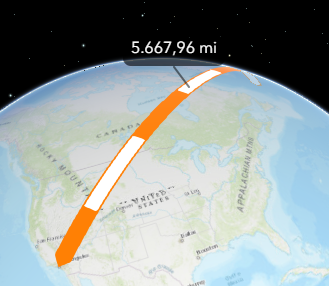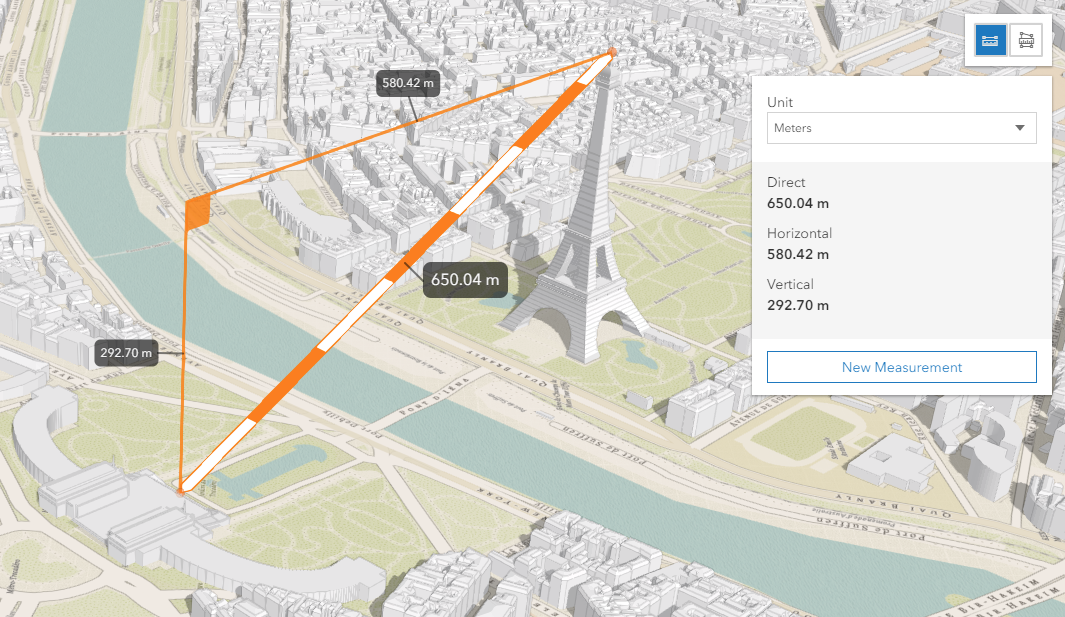DirectLineMeasurement3D
require(["esri/widgets/DirectLineMeasurement3D"], function(DirectLineMeasurement3D) { /* code goes here */ });esri/widgets/DirectLineMeasurement3DThe DirectLineMeasurement3D widget calculates and displays the 3D distance between two points. This widget can be used in a SceneView to measure the vertical, horizontal, and direct distance between two points.
When the widget is active, a horizontal "laser" line is drawn which indicates the height at the current mouse position. This line can help in analyzing the heights of objects relative to each other and the terrain. A second laser line shows the intersection of the scene with the vertical plane that passes through the checkered line.
DirectLineMeasurement3D widget labels the direct, horizontal, and vertical orange distance lines and displays the same values in the UI panel. In a WGS84 or WebMercator scene, when the distance between the points is greater than 100 km, DirectLineMeasurement3D widget switches to displaying only the Horizontal and Vertical distances taking into consideration the curvature of the earth (i.e. ellipsoid-based geodesic distance).

This widget is designed to work with 3D SceneViews. For measurements with 2D MapViews, use DistanceMeasurement2D.
- See also:
var measurementWidget = new DirectLineMeasurement3D({
view: view
});
view.ui.add(measurementWidget, "top-right");Constructors
- new DirectLineMeasurement3D(properties)
- Parameter:properties Objectoptional
See the properties for a list of all the properties that may be passed into the constructor.
Example:// typical usage var measurementWidget = new DirectLineMeasurement3D({ view: view });
Property Overview
| Name | Type | Summary | Class | |
|---|---|---|---|---|
| String|HTMLElement | The ID or node representing the DOM element containing the widget. more details | more details | Widget | |
| String | The name of the class. more details | more details | Accessor | |
| String | The widget's default CSS icon class. more details | more details | DirectLineMeasurement3D | |
| String | The unique ID assigned to the widget when the widget is created. more details | more details | Widget | |
| String | The widget's default label. more details | more details | DirectLineMeasurement3D | |
| SystemOrLengthUnit | Unit system (imperial, metric) or specific unit used for displaying the distance values. more details | more details | DirectLineMeasurement3D | |
| SystemOrLengthUnit[] | List of unit systems (imperial, metric) and specific units for displaying the distance values. more details | more details | DirectLineMeasurement3D | |
| SceneView | A reference to the SceneView. more details | more details | DirectLineMeasurement3D | |
| DirectLineMeasurement3DViewModel | The view model for this widget. more details | more details | DirectLineMeasurement3D |
Property Details
The ID or node representing the DOM element containing the widget. This property can only be set once. The following examples are all valid use cases when working with widgets.
Examples:// Create the HTML div element programmatically at runtime and set to the widget's container const basemapGallery = new BasemapGallery({ view: view, container: document.createElement("div") }); // Add the widget to the top-right corner of the view view.ui.add(basemapGallery, { position: "top-right" });// Specify an already-defined HTML div element in the widget's container const basemapGallery = new BasemapGallery({ view: view, container: basemapGalleryDiv }); // Add the widget to the top-right corner of the view view.ui.add(basemapGallery, { position: "top-right" }); // HTML markup <body> <div id="viewDiv"></div> <div id="basemapGalleryDiv"></div> </body>// Specify the widget while adding to the view's UI const basemapGallery = new BasemapGallery({ view: view }); // Add the widget to the top-right corner of the view view.ui.add(basemapGallery, { position: "top-right" });
- Since: ArcGIS API for JavaScript 4.7
The name of the class. The declared class name is formatted as
esri.folder.className.
- iconClass String
The widget's default CSS icon class.
The unique ID assigned to the widget when the widget is created. If not set by the developer, it will default to the container ID, or if that is not present then it will be automatically generated.
- label String
The widget's default label.
- unit SystemOrLengthUnitSince: ArcGIS API for JavaScript 4.8
Unit system (imperial, metric) or specific unit used for displaying the distance values.
- unitOptions SystemOrLengthUnit[]Since: ArcGIS API for JavaScript 4.7
List of unit systems (imperial, metric) and specific units for displaying the distance values.
- viewModel DirectLineMeasurement3DViewModelautocastSince: ArcGIS API for JavaScript 4.7
The view model for this widget. This is a class that contains all the logic (properties and methods) that controls this widget's behavior. See the DirectLineMeasurement3DViewModel class to access all properties and methods on the widget.
Method Overview
| Name | Return Type | Summary | Class | |
|---|---|---|---|---|
| String | A utility method used for building the value for a widget's | more details | Widget | |
Destroys the widget instance. more details | more details | Widget | ||
| Boolean | Emits an event on the instance. more details | more details | Widget | |
| Boolean | Indicates whether there is an event listener on the instance that matches the provided event name. more details | more details | Widget | |
| Object | Registers an event handler on the instance. more details | more details | Widget | |
Widget teardown helper. more details | more details | Widget | ||
This method is primarily used by developers when implementing custom widgets. more details | more details | Widget | ||
| Object | This method is primarily used by developers when implementing custom widgets. more details | more details | Widget | |
Renders widget to the DOM immediately. more details | more details | Widget | ||
This method is primarily used by developers when implementing custom widgets. more details | more details | Widget |
Method Details
- Since: ArcGIS API for JavaScript 4.7
A utility method used for building the value for a widget's
classproperty. This aids in simplifying CSS class setup.Parameter:repeatable The class names.
Returns:Type Description String The computed class name. Example:// .tsx syntax showing how to set CSS classes while rendering the widget render() { const dynamicIconClasses = { [CSS.myIcon]: this.showIcon, [CSS.greyIcon]: !this.showIcon }; return ( <div class={classes(CSS.root, CSS.mixin, dynamicIconClasses)} /> ); }
- destroy()inherited
Destroys the widget instance.
Emits an event on the instance. This method should only be used when creating subclasses of this class.
Parameters:type StringThe name of the event.
event ObjectoptionalThe event payload.
Returns:Type Description Boolean trueif a listener was notified
Indicates whether there is an event listener on the instance that matches the provided event name.
Parameter:type StringThe name of the event.
Returns:Type Description Boolean Returns true if the class supports the input event.
Registers an event handler on the instance. Call this method to hook an event with a listener.
Parameters:A event type, or an array of event types, to listen for.
listener FunctionThe function to call when the event is fired.
Returns:Type Description Object Returns an event handler with a remove()method that can be called to stop listening for the event(s).Property Type Description remove Function When called, removes the listener from the event. Example:view.on("click", function(event){ // event is the event handle returned after the event fires. console.log(event.mapPoint); });
- own(handles)inherited
Widget teardown helper. Any handles added to it will be automatically removed when the widget is destroyed.
Parameter:handles WatchHandle|WatchHandle[]Handles marked for removal once the widget is destroyed.
- postInitialize()inherited
This method is primarily used by developers when implementing custom widgets. Executes after widget is ready for rendering.
This method is primarily used by developers when implementing custom widgets. It must be implemented by subclasses for rendering.
Returns:Type Description Object The rendered virtual node.
- renderNow()inherited
Renders widget to the DOM immediately.
- scheduleRender()inherited
This method is primarily used by developers when implementing custom widgets. Schedules widget rendering. This method is useful for changes affecting the UI.
